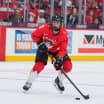WINNIPEG -- Here is one way to almost guarantee a hockey season full of travel nightmares: having players fly dozens of times between Winnipeg, in the center of Canada, and St. John's, the capital of Newfoundland and Labrador at the easternmost point of the country, with no direct flights.
Between 2011-12 and 2014-15, the Winnipeg Jets and their American Hockey League affiliate at the time, the St. John's IceCaps, carried on their business this way, at times defying the travel gods in winter weather, separated by 2 1/2 time zones and, as the crow flies, 2,004 miles.
Jets keeping closer eye on prospects with AHL affiliate in-house
Say improved logistics make for better player development in new NHL model
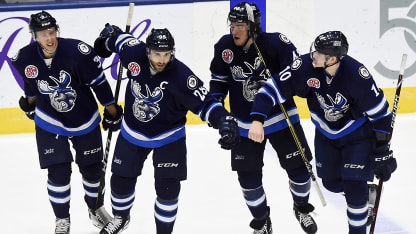
© Graig Abel/Getty Images
By
Tim Campbell
NHL.com Staff Writer
The adventures were many, forward Patrice Cormier said.
"It's my first year with the Jets (2011-12), the first year the Jets are back in Winnipeg and I thought I was making the team," Cormier said. "I had been practicing with Nik Antropov and [Alexander] Burmistrov on a line. Three days before the first game, they picked up Brett MacLean on waivers and I got sent down.
"Tanya, my girlfriend and now my wife, was coming out to Winnipeg. I called her and she was in Toronto, between flights, and I said to her, 'Don't take your next flight to Winnipeg because I'm going to St. John's.'
"She said, '[Never mind] this, I'm going back to Moncton.' About a week later, I told her it was going to be OK to come to St. John's, so she flew to St. John's. The first day she was there, we had just fallen asleep that night and the phone rings at midnight, no lie, and they're telling me to come back to Winnipeg.
"Sure, I was excited. We laugh about it now."
It's all in the rearview mirror, of course, so the laughter comes a little easier.
Today, Cormier, 27, plays for the Manitoba Moose, the Jets' AHL affiliate that was moved back to Winnipeg's Bell MTS Place to start the 2015-16 season, making it the home arena for both.
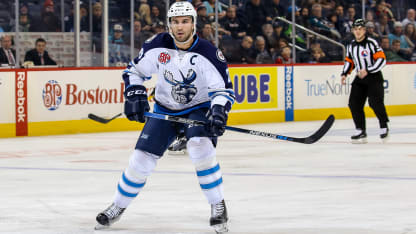
© Jonathan Kozub
After years of taxing trips, the long and the short of it is this: The Jets decided the best place for their prospects to be developing and playing is at home, where a roster recall can be as simple as an email to NHL Central Registry and a walk down the hall.
The best case for new travel distance and time: 170 steps and about 90 seconds. No plane tickets, no cabs, no lost luggage or sleep.
"Best thing is you sleep in your own bed every night," Cormier said.
The arrangement in Winnipeg is part of a clear trend of NHL teams bringing their AHL affiliates closer.
Five years ago, the average distance between NHL teams and AHL affiliates was 776 miles, with 11 affiliates more than 1,000 miles from their respective parent clubs, according to figures provided by the AHL. Seven were within 100 miles.
This season, the average distance is 387 miles. Five AHL teams are more than 1,000 miles away from their NHL teams but 13 are now 100 miles or less apart, and 20 of 30 NHL teams have their affiliate no more than 167 miles away.
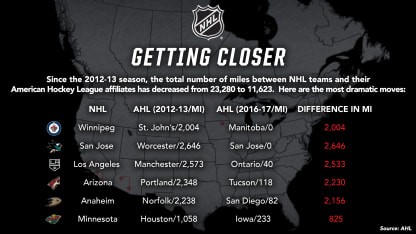
In two cases, the teams are zero miles apart: the Jets and Moose, and the San Jose Sharks and their AHL affiliate, the San Jose Barracuda, who share an arena, SAP Center.
Dave Andrews, president and CEO of the AHL, said better development and shorter distances have become priorities.
"One of the things that was true when the Jets were in St. John's, and true for all of the West Coast teams who had [AHL] teams in the East, not only was recall travel difficult, but more importantly the ability to monitor the progress of the players was really challenging," Andrews said. "As the investment gets greater in terms of the human resources being put into the coaching side, the need to monitor that and the desire on the part of senior management and ownership to be able to monitor the development of players is really critical."
Shorter distances have made life easier for the Jets and their prospects logistically, but how an AHL player's proximity to the NHL team affects his thinking and his view of his own career possibilities is less quantifiable. Some players say they see a correlation.
"Personally, when I was in St. John's, it just felt like it was more of a dream than reality," said defenseman Julian Melchiori, 26, who played three seasons in St. John's and is in his third with the Moose. "Isolated is the right word. You felt like a pro hockey player but [less like] a potential NHL guy."
Having also lived the distance, Cormier said it was "absolutely awful, probably the worst thing I ever went through.
"It felt far. It was far. Imagine the difference now. Somebody on the Jets gets hurt yesterday morning and (forward Brendan) Lemieux is practicing with us and at 12:30, he's on the flight with the Jets. What an advantage of having your team right here. And what a disadvantage of having a team in St. John's before."
Melchiori, who has played 30 NHL games with the Jets since 2013-14, said his chances for a call-up feel more realistic playing in Winnipeg. And he said his Manitoba teammates feel the same way, some of them to the point where they are acutely tuned in to every action, every nuance with the NHL team.
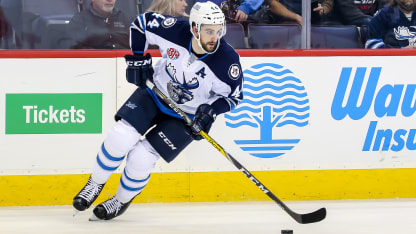
© Jonathan Kozub
This is the next set of mental exercises for prospects who are out-of-their-skin eager for any opportunity.
Winnipeg -- fans, media, Moose, everyone -- is hyperfocused on the Jets. You seemingly cannot go anywhere in the city without seeing a Jets logo or hear a Jets-related conversation. It may well be the NHL market where the team's brand is omnipresent.
"You drive down Portage (Avenue) and all you see is Jets," Melchiori said. "It's everywhere. It's hard to not think about it. Being here for a few years now, I think I've learned to not think about it as much. I see with a lot of our young guys, well, we all watch every Jets game we can but guys are texting during the game about whether this guy fell or that guy didn't return. I think I was like that, but not so neurotic.
"I don't think it's a fault by any means. Everybody wants to play so bad."
Focusing on one's business is not unique, but the closeness of the NHL and AHL teams in Winnipeg shines a bright light on this particular kind of discipline.
Forward Nic Petan, 22, knows plenty about potential distractions from the other team in Winnipeg. He has played for the Jets (88 games) and Moose (95 games) in each of the past three seasons. He has made a strong case for more NHL time, with 41 points (12 goals, 29 assists) in 39 AHL games this season, and scored for the Jets against the Arizona Coyotes on Tuesday after being called up.

© Graig Abel/Getty Images
"I guess when you're up [in the NHL], you don't think about it as much, because you're up and you've got enough to think about," said Petan, selected in the second round (No. 43) of the 2013 NHL Draft. "You don't want to be down here. That's option No. 1.
"Option No. 2, when you're down here, you do think about going up and what's going to happen. The work ethic down here has to be great every day to get an opportunity to go back up."
Would a prospect actually force himself not to think of playing for the Jets?
"You try not to think about it and it's not as selfish as it sounds, but you just want to be on your own page, worry about yourself," Petan said. "You stick to the plan, focus on team things. But as an individual, it's about not taking shortcuts, being in the gym after games and doing things that potentially can help you in the future."
Forward Kyle Connor, selected by the Jets in the first round (No. 17) of the 2015 NHL Draft, played 52 games for Manitoba last season and four at the start of this season. The 21-year-old also said he shut out distractions by keeping a tight focus on himself in the AHL.
"For me, it was easy," said Connor, who has 35 points (18 goals, 17 assists) in 49 games with the Jets this season. "I was not using energy to not think about it. I was playing and having fun and trying to work hard with the Moose when I was there."

© Jonathan Kozub
Some prospects say they stifle NHL thoughts daily; others say they embrace them at every opportunity.
"I think each player handles it differently," said Manitoba goaltender Michael Hutchinson, who's 15-2-4 in the AHL and won his only game with the Jets this season. He went 9-12-3 in 28 games (20 starts) for them last season. "Go through our whole dressing room and you'll get different answers. For some, it's motivation. For some, it's a distraction. For some, it's frustration. For me, the AHL schedule and NHL schedule means we're rarely in the same place at the same time, so you don't really see anyone around. It's nice to have the familiarity with the city and Winnipeg is now my home.
"So that's nice not to have to move around at all. But I think the situation is what you make it as a player."
Jets defenseman Josh Morrissey spent 2015-16 with Manitoba, save for being called up for his first NHL game, at home against the Montreal Canadiens on March 5, 2016.
He does not remember ever averting his gaze from the Jets, whether down the hall, or skating on another sheet at the teams' practice facility, the Bell MTS Iceplex.
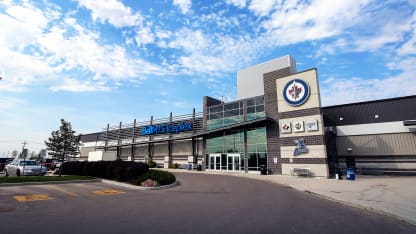
Morrissey, a first-round pick by the Jets (No. 13) in the 2013 NHL Draft, is one of those players who let the in-your-face presence of the NHL in Winnipeg motivate them daily.
"From a player's perspective, the dream and the goal is to play in the NHL and when you're across the hall, there's nothing more you want than eventually to be in that locker room," Morrissey said. "So for me, it was something that every single day I tried to have the mindset of, 'That's where you want to get to and that's what you're working toward.'
"My view every day was to try to get better and you want to be in that locker room. You see the carrot. Then you work that much harder to try to get there."
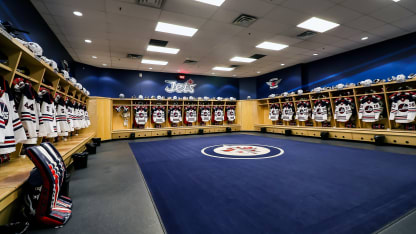
© Jonathan Kozub
Morrissey, in his second NHL season, has quickly become one of the Jets' key defensemen. The 22-year-old has 19 points (five goals, 14 assists) in 52 games this season and is averaging 20:21 of ice time per game despite playing little on the power play (19 seconds per game).
He said that while with the Moose, he didn't just think about the carrot, he often chased it to Bell MTS Place for Jets games.
"I would watch lots of their games, to see what they're doing," Morrissey said. "I've always watched (Jets defenseman) Toby Enstrom lots since I've been drafted here. I probably came to 10 games over that year (2015-16), to watch from the press box. It gives you a better eye on things. I liked to come watch when they were playing against some of the top defensemen in the League, guys like Drew Doughty and Duncan Keith especially, and watch them close. It was a great resource you could use."

© Graig Abel/Getty Images
\\\\
In the NHL's smallest market, Jets general manager Kevin Cheveldayoff has made development a priority. When the Jets brought their AHL affiliate back to Winnipeg, the primary purpose was to improve it, but Cheveldayoff said with the new logistics of having two teams in Winnipeg, some of the Manitoba players' everyday concerns are reduced.
"If I get called up, do I keep my apartment?" Cheveldayoff said, rattling off concerns players would commonly have if the affiliate were not so close by. "Do I not keep my apartment? What do I do with my family? What do I do with my girlfriend? What do I do with my car? I have to pay bills. Should I pay this one or that one when I'm called up or sent down? All of those kinds of distractions are just taken away.
"You're settled. You know you're here to play hockey. You have to live, but one of the biggest things for kids coming from junior into pro hockey is learning about taking care of your own life. From that aspect, it's made a lot more simple for them.
"And if you do have a wife or kids or girlfriend, you know you're going to home to them every single night."
Another benefit of the current setup is streamlined communication within the organization. Cheveldayoff practically beamed when he said that he and/or assistant general managers Craig Heisinger and Larry Simmons can simply take a short walk to Manitoba coach Pascal Vincent's office for a chat.
For them and Jets coach Paul Maurice, it's easier to attend AHL games to assess the development process and players' progress.
"You run into the players themselves and have casual conversations with them," Cheveldayoff said. "For me, I think the whole communication side of it, you can't put a value on that, the ability to have that 1-on-1 dialogue with coaches and players."
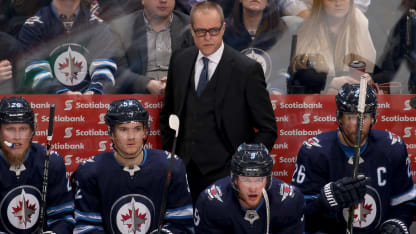
© Jonathan Kozub/Getty Images
The new geography has also made Jets player-development assistant and former Canadiens captain Mike Keane more useful. Keane, who played 16 NHL seasons for the Canadiens, Colorado Avalanche, New York Rangers, Dallas Stars, St. Louis Blues and Vancouver Canucks, lives in Winnipeg and spends plenty of time on the ice with the Moose.
"I watch practice more, watch their practice habits," Keane said. "Some days I don't even go on the ice and I'll watch practice because you can see things better from up top. You get some really good detail from that, then after you can give players more detail.
"The more contact, the more views, the more communication we have with our young players, that's a bonus. Especially now with today's player. They want information. They want video. They want more ice time. They want to work on things after practice."
Asked if this setup helped players like Connor and Morrissey reach the NHL faster or better establish themselves, Keane said, "Good question. … I can see it making players more hungry, because you are literally across the street. You always have eyes on you.
"Every game at home you know you'll have a lot more important people looking at your play. … So no player would want to ever have that one bad game and you'll work at it harder."
Or, as Morrissey put it, "Here, if you're playing well or not playing well, they know. The communication part of it … that's huge having Mike around."
For Maurice, it's also a big plus that Vincent is around, under the new setup. Vincent, one of his assistants from 2011 to 2016, is in his second season as Manitoba coach.
"He does a fantastic job, and his motivation for coaching is right," Maurice said. "He's there to help people. He really cares. That was his strength (as a Jets assistant), that he cared about everybody, tried to have a relationship with every player and that's the way he coaches.
"Now I get to see the [prospects] play a few times. And Pascal and I would talk about them. From my point of view, working with Pascal is outstanding."
Maurice said there are many benefits to having the Moose in Winnipeg. More fan discourse about and knowledge of the prospects is one. Another is that they practice in an NHL facility.
"The players come in and know it's pro hockey," he said. "They know there's another level but it's a good place."
But the reduced travel for the players shuttling to and from Jets is the biggest advantage to having the AHL affiliate housed in Winnipeg, Maurice said.
"The wear and tear on these guys who used to come from the East Coast, they don't have to sit on an airplane for hours," Maurice said. "Sometimes playing them was, 'What's the point having a guy come from all those airplanes to see how good he is?' This gives the players a better chance."
\\\\
The Jets and Moose use the same arena and practice facility. Their management is essentially one group and shares conversation, discussion, ideas and evaluations, as Maurice said.
Beyond that, the teams don't share much.
They have separate dressing rooms, the Jets on the west side and the Moose on the east side of Bell MTS Place. Each team has its own dressing room, showers, lounges and practice-ice sheets at the four-ice Bell MTS Iceplex.
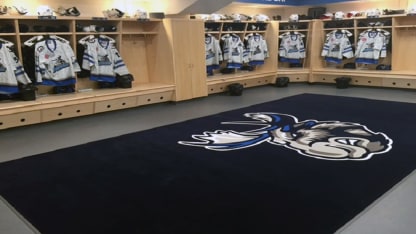
The upper-level weight room and some medical facilities and meeting rooms are shared at the Iceplex, but there is a separation, a clear line with regard to who belongs where when the teams are home, which Keane said is deliberate.
The demarcation, however, does not prevent closeness. There are many strong personal ties that reach across the line.
"Honestly, I think it's amazing," Melchiori said. "When I'm playing on the Moose, I can still hang out with them (the Jets) outside the arena. (Jets forward) Mark Scheifele is one of my good friends. I still see him.
"I know the trainers and players on that side and this, so when you get the (NHL) call, it's exciting that way, that you see guys I've become very close with."
The teams' differing schedules -- often when one is home, the other is on the road -- limit how much the players' paths cross.
"You're just on your own schedule, routine," Petan said. "Everyone respects each other, whether you get sent down or not. It's all pretty solid."
Cormier said the organization's prospects benefit from the exposure to the Jets and the relationships formed with them.
"It has to be a motivation," Cormier said. "Take Brendan and Jack [Roslovic], they live in the same building as (Jets forward) Matt Hendricks. That can only be good. He takes them under his wing. It's almost like a big team, a big-picture group.
"There's a line there but there's respect. They don't make us feel small. In the mornings, we go in the gym to work out. Some of the [Jets] guys who might be hurt are in there. Nobody says, 'Get the hell out of our gym.' They're great about it. They treat the young guys well."
And beyond interaction, Cormier said there is great value in observing an NHL team up close.
"You see the vibe around the city," Cormier said. "You have to be impressed with the way they're playing and having our young guys watch how [Mathieu] Perreault and Scheifele are working, and [Blake] Wheeler. You have to be good every night to play in that league. Wheeler and Scheifele are good, but the work they put in can't not rub off on our guys. How can you not build on that?
"It's a great challenge and great opportunity for these guys. And they're working hard at it. I don't think we'll have some of them here for long."
Cheveldayoff said those relationships show that character can really pay off.
"The age demographics of the two teams aren't that different," he said. "You've got a lot of guys that span both demographics. But the players on the Jets side who are established NHLers and veterans, they're great guys, guys who are inclusive, not talk-to-the-hand type guys. They're approachable and they all know each other. They go to training camp together and when the call-ups do happen from the Moose to the Jets, there isn't that kind of wide-eyed, holy-smokes, can-I-talk-to-[Dustin Byfuglien], can-I-talk-to-[Wheeler] feeling. It's a whole sense that it's just one big organization."
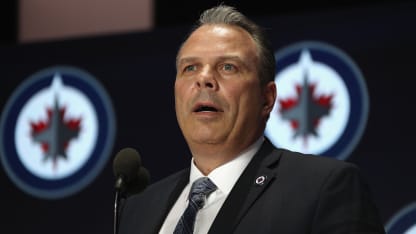
© Dave Sandford/Getty Images
\\\\
Winnipeg (32-14-9) is in second place in the Central Division, two points behind the Nashville Predators; it had been tied for first entering Saturday, the latest point in a season it had led the division since the 2011 relocation from Atlanta. Manitoba (32-11-3) is first in the Central Division and Western Conference of the AHL.
The results are telling Mark Chipman, executive chairman of True North Sports + Entertainment, which owns the Jets and Moose, that bringing the AHL affiliate to Bell MTS Place in 2015 was the right move.
The Moose struggled at first, going 26-41-9 in 2015-16, then 29-37-10 last season, when management went all-in on youth.
"We erred on the side of pure development and we struggled," Chipman said. "Kevin and our hockey group rightfully decided we needed to determine if these kids could play.
"Now what you're seeing is a team where some of those players revealed that they weren't able to get to the next level, and we've moved on from some early drafts, and the ones that have stuck with us have gotten better."
Chipman sounds just as positive about the improved logistics. He said he appreciated having good partners in an excellent hockey market in St. John's, but that the extreme distance was unworkable.
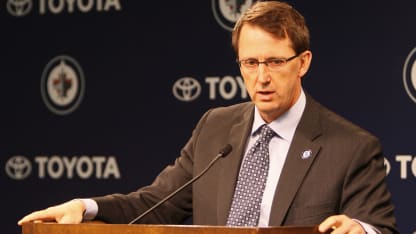
© Travis Golby/Getty Images
"What we have now are real benefits to literally being in the same building, for our players and for our coaches," he said. "For Paul to be able to put on his coat and come down to the rink and watch an AHL game, well, he can do that and he's done it.
"And there are perhaps less tangible aspects of just being able to introduce our young kids into the culture of the Winnipeg Jets right out of the gate. They can sense it and be a part of it right from training camp on. These are hard things to quantify. You just kind of know them when you see them and feel them. For all of those reasons, we think it's working for us."
Chipman has enough NHL and AHL history to give him perspective.
Purchased by a group that included Chipman, the Moose came to Winnipeg from Minnesota as a member of the International Hockey League in 1996, when the original Jets became the Phoenix Coyotes.
The Moose and five other IHL teams joined the AHL in a merger in 2001, at about the time Chipman took full control and created True North, which built Bell MTS Place. The Moose were the Vancouver Canucks' AHL affiliate for 10 years until the Atlanta Thrashers relocated to Winnipeg in 2011 and became the Jets.
When True North brought the Jets back to Winnipeg, Chipman said, they moved their affiliate to St. John's, thinking it best to find another home for the AHL team so they could focus on the relaunching the NHL in the city.
Chipman said True North has never had any worry about the AHL siphoning NHL interest or attendance in Winnipeg. The Jets have sold out all 255 regular-season home games they've played since 2011 and have a waiting list for 6,500 season seats.
Winnipeg provided strong support to the AHL team before that. During a period that was instrumental for True North to finds its legs operating a team, the Moose averaged between 7,769 and 8,626 fans per game between 2004, when Bell MTS Place opened, and 2011. Their average attendance was 7,285 in 2015-16, the first season back, and is 5,393 per game this season following two seventh-place finishes by the Moose in the Central.
When the affiliate was in St. John's, the Jets were paid an affiliation fee by the group operating the team there. Chipman said that on the business side, the return of the Moose to Winnipeg has basically been a wash, even with no affiliation-fee payment and factoring in the added expense of selling tickets and ads on the rink boards.
Chipman said one less obvious upside to the arrangement is that the Moose have their own staff in charge of those areas, as well as a separate game-production team.
"They're developing in the business of pro hockey, too," he said, "so that's a plus."
Chipman said he considers the Moose to be in Winnipeg permanently. His hope is that having the prospects much closer means sustained success for the Jets is not far away.
"Everything we're trying to do is to try to ensure consistent, long-term success," he said. "When you find something that is working, stick with it. Our ultimate goal is to create a team (in the NHL) that challenges every year, and I don't think you can do that by lurching back and forth on your underlying model. Ours has been to draft, develop and retain high-quality players.
"We think this model works, and as long as it does we're going to stick with it."








